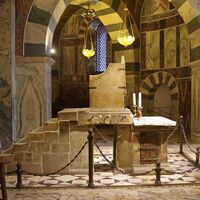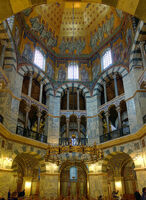Palace and chapel at Aachen
Type:
Chapels,
Churches,
Doors,
Mosaics,
Palace complexes,
Lamps,
Secular architecture
Date:
805 (dedication),
1355 to 1414 (choir expansion)
Location or Findspot (Modern-Day Country):
Germany
Description:
At the end of the eighth century, Charlemagne (ca. 748–814) chose Aachen as the main palace of his traveling court. Two-story walkways connected a monumental central gatehouse with an apsed audience hall to the north and a chapel to the south. Additional buildings included a library-scriptorium, a mint, and housing for family and troops. There was also a royal hunting park and menagerie, which housed the elephant sent to Charlemagne as a diplomatic gift by Harun al-Rashid, the Abbasid caliph in Baghdad. The palace has only been partially recovered archaeologically, but scholars have reconstructed its layout from Carolingian poems that led listeners through the spaces.
The octagonal chapel was built by Odo of Metz and dedicated in 805. It was lavishly decorated with new works in bronze and with marble and porphyry spolia. Booty from the Avars defeated in 796 helped fund the chapel, which also attracted many later donations; the central chandelier was given in the 1160s by King Frederick I Barbarossa.
Aachen was raided by Vikings later in the ninth century and renovated by the Ottonians in 983. Pilgrimage to the site increased after Charlemagne was (unofficially) canonized in 1165 and his remains translated to a Roman sarcophagus and then, in 1215, to a golden reliquary shrine. Between 1355 and 1414, the palace chapel was extended eastward with a new Gothic-style choir. German kings and Holy Roman Emperors were crowned at Aachen until the sixteenth century.
The octagonal chapel was built by Odo of Metz and dedicated in 805. It was lavishly decorated with new works in bronze and with marble and porphyry spolia. Booty from the Avars defeated in 796 helped fund the chapel, which also attracted many later donations; the central chandelier was given in the 1160s by King Frederick I Barbarossa.
Aachen was raided by Vikings later in the ninth century and renovated by the Ottonians in 983. Pilgrimage to the site increased after Charlemagne was (unofficially) canonized in 1165 and his remains translated to a Roman sarcophagus and then, in 1215, to a golden reliquary shrine. Between 1355 and 1414, the palace chapel was extended eastward with a new Gothic-style choir. German kings and Holy Roman Emperors were crowned at Aachen until the sixteenth century.
Relevant Textbook Chapter(s):
5,
10
Repository and Online Resources:
• The Aachen Cathedral, with Charlemagne's palace chapel at its core, was among the first places to become a UNESCO World Heritage Site.
• Read about the Aachen Palatine chapel on the Khan Academy website.
• See a 3D model of the palace here.
• See a seventeenth-century drawing of the lost mosaic vault of the palace chapel here.
Image Credits:
Wikimedia Commons; Navid Jamali








